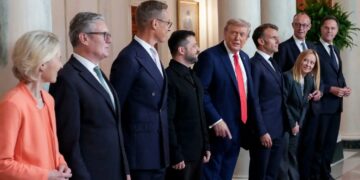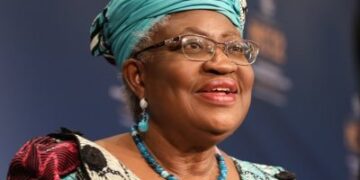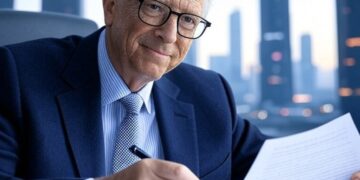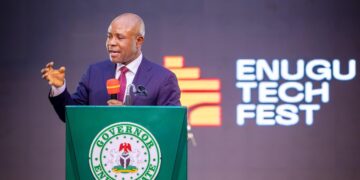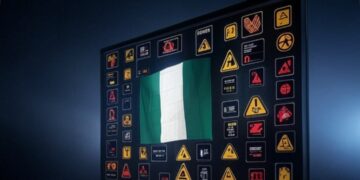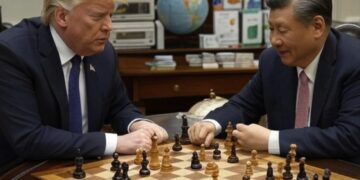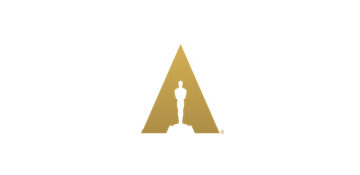On January 20, 2025, Donald J. Trump was sworn in as the 47th President of the United States, ushering in his second term after a four-year absence from the White House. Less than two months later, the reverberations of Trump 2.0 are palpable across the globe. Unlike his first term, marked by unpredictability and adaptation, this administration arrived with a seasoned team, a Republican-controlled Congress, and a clear intent to execute an amplified “America First” agenda. For stakeholders—governments, corporations, NGOs, and citizens—the early days of Trump’s second term have already redefined global politics, economics, and security.
Trump’s initial moves—imposing sweeping tariffs, slashing foreign aid, and signaling a retreat from multilateral commitments—have set a confrontational tone. From North American trade wars to strained European alliances, Middle Eastern recalibrations to African disengagement, the world is adjusting to a United States that prioritizes unilateral action over collective solutions. This updated article examines the seismic impact of Trump 2.0 across five critical dimensions: international alliances, economic interdependence, security and conflict, climate action, and the future of global institutions. Each section reflects developments as of March 11, 2025, offering stakeholders insights into the stakes, shifts, and strategies defining this transformative era.
1. International Alliances: Fractures Deepen, New Alignments Emerge
Trump’s return has intensified strains on traditional alliances while sparking tentative new partnerships. In Europe, his skepticism of NATO, once rhetorical, has become actionable. By early March 2025, Trump demanded that NATO allies meet their 2% GDP defense spending targets within six months or face reduced U.S. troop commitments. This ultimatum, coupled with his February 17 emergency summit snub in Paris—where European leaders like Emmanuel Macron and Olaf Scholz convened to address his policies—has pushed the continent toward greater strategic autonomy. Stakeholders in European defense, such as Airbus and Thales, are eyeing increased contracts as nations like Poland and the Baltics bolster their militaries independently, wary of Russian opportunism.
The Ukraine conflict remains a flashpoint. Trump’s administration, led by envoy Steve Witkoff, proposed a trilateral summit in Riyadh with Ukrainian President Volodymyr Zelensky and Russia’s Vladimir Putin, set for May 2025. This followed a contentious February 28 White House meeting where Trump and Zelensky clashed publicly over war strategy, with Trump pushing for territorial concessions to end the conflict swiftly. European leaders, particularly in France and Germany, decry this as a capitulation to Moscow, fearing it could embolden Putin’s regional ambitions. Defense stakeholders like Rheinmetall anticipate a pivot in arms sales from Ukraine to Asia, aligning with Trump’s focus on countering China.
In Asia, Trump’s hardline stance on China has escalated. His March 4 announcement of 20% tariffs on Chinese goods—doubling previous duties—has rattled Japan and South Korea, key allies reliant on U.S. security guarantees. South Korea, still reeling from its 2024 political crisis, faces Trump’s renewed demands for higher payments to maintain U.S. troops, straining bilateral ties. Japan, under Prime Minister Shigeru Ishiba, is navigating this shift by deepening trade ties with India and Australia, anticipating a U.S. pivot away from multilateral frameworks like the Quad. Stakeholders in Asian tech—Sony, Samsung—brace for supply chain disruptions as tariffs threaten regional stability.
India, meanwhile, emerges as a winner. Trump’s anti-China posture has accelerated U.S.-India collaboration, with New Delhi positioning itself as a manufacturing alternative. Stakeholders in Indian industry—Tata, Reliance—see opportunities in Trump’s tariff-driven reshoring, though they must contend with his transactional diplomacy. Across the Asia-Pacific, the risk of miscalculation looms, particularly over Taiwan, where China’s military drills intensified post-inauguration.
2. Economic Interdependence: Trade Wars Ignite, Markets Reel
Trump’s protectionist economic agenda has roared to life, reshaping global trade in mere weeks. On March 4, 2025, he imposed 25% tariffs on imports from Canada and Mexico, alongside the 20% duties on China, targeting America’s top three trading partners. This escalation, effective immediately, has sparked trade wars with profound implications for stakeholders in commerce and finance.
North America is reeling. Canada’s integrated supply chains—oil, timber, autos—face chaos, with companies like Magna International warning of layoffs. Mexico’s export-driven economy, from avocados to car parts, is similarly imperiled, prompting retaliatory tariffs on U.S. goods. The resignation of Canadian Prime Minister Justin Trudeau in late 2024, partly tied to Trump’s tariff threats, has left Ottawa scrambling under interim leadership. Stakeholders in U.S. manufacturing—Ford, GM—confront rising costs, with some eyeing relocation to tariff-free zones like Vietnam.
China’s response has been swift. Beijing countered with tariffs on U.S. agricultural exports—soybeans, pork—deepening the economic divide. Its state media touts self-reliance, accelerating decoupling efforts begun in Trump’s first term. Stakeholders in global retail—Walmart, Amazon—face higher prices as Chinese electronics and textiles grow costlier, while Southeast Asia (Malaysia, Thailand) gains as alternative hubs. The Shanghai Composite plummeted 5% post-tariff announcement, reflecting market jitters.
Europe, though not directly targeted, feels the ripple effects. The European Central Bank, on March 6, warned of inflationary pressures as global trade fragments. German automakers (BMW, Mercedes) and French luxury firms (LVMH) report declining U.S. sales forecasts, prompting a pivot to Asian markets. Stakeholders in European renewables—Siemens Gamesa—see potential in filling U.S. leadership gaps, though Trump’s fossil fuel push complicates green investments.
Developing economies face a stark choice. Trump’s February 27 decision to eliminate over 90% of USAID’s foreign aid contracts—reducing its workforce from 14,000 to 294—signals a retreat from traditional assistance. Nations in Africa and Latin America, like Kenya and Guatemala, are turning to China’s Belt and Road Initiative, despite debt risks. Stakeholders in commodities—copper from Zambia, coffee from Colombia—must adapt to a U.S. market favoring domestic sourcing, reshaping decades-old trade patterns.
3. Security and Conflict: Deals, Disengagement, and New Risks
Trump’s security policy blends deal-making with disengagement, yielding mixed results. In Ukraine, his Riyadh summit plan aims to “end the war fast,” as pledged on March 3 during a budget announcement tying $30 billion in aid to Zelensky’s cooperation. This transactional approach—aid for peace talks—has drawn European ire, with NATO’s Mark Rutte urging a united front. Stakeholders in U.S. defense—Lockheed Martin, Boeing—anticipate a shift in focus to Asia, where Trump’s China hawkishness drives demand.
The Middle East sees Trump’s influence grow. Israeli Prime Minister Benjamin Netanyahu, buoyed by Trump’s January 20 pledge of unwavering support, intensified Gaza operations, expecting no U.S. pushback. A potential Saudi-Israel normalization deal, teased in February, could stabilize oil markets—welcome news for stakeholders like BP and Shell—though Iran’s proxy escalation in Yemen tests this optimism. Trump’s past withdrawal from the Iran nuclear deal fuels speculation of renewed sanctions or military action, risking energy supply shocks.
Africa, largely ignored in Trump’s first term, faces further neglect. The USAID cuts have paralyzed humanitarian missions, with only 12 staff left for the entire continent. Stakeholders in counterterrorism—UN, African Union—warn of resurgent threats like Al-Shabaab as U.S. drones and training dwindle. Yet Trump’s deal-making instinct could spark ad hoc partnerships with resource-rich nations—think Nigeria’s oil or Congo’s cobalt—if they align with U.S. interests.
Trump’s unpredictability remains a wildcard. His March 5 tariff rollout, framed as a “reconnaissance through battle” by Polish Foreign Minister Radosław Sikorski, tests adversaries and allies alike. Stakeholders in global security must brace for sudden pivots—peace in Ukraine could free Russian resources for Syria, or tariff tensions could ignite a South China Sea clash—demanding agile responses in an unstable world.
4. Climate Action: A Fossil Fuel Renaissance Amid Global Despair
Trump’s climate skepticism has crystallized into policy. On February 4, 2025, he signed an executive order withdrawing the U.S. from the UN Human Rights Council, UNRWA, and signaling a review of UNESCO membership—steps foreshadowing a Paris Agreement exit, confirmed March 7. This retreat, paired with a pro-fossil fuel agenda, devastates global climate efforts. Stakeholders in green tech—Vestas, BYD—face a U.S. market prioritizing “liquid gold” over renewables.
The U.S. pullback guts climate finance. The $300 billion COP29 goal, set in November 2024, falters without America’s 20% UNFCCC contribution. Developing nations—Bangladesh, Tuvalu—plead for aid as floods and heatwaves worsen, turning to China’s green tech largesse. Stakeholders in oil—ExxonMobil, Chevron—celebrate Trump’s deregulation, with Permian Basin output surging, though oversupply risks crashing prices.
Paradoxically, U.S. clean energy persists. The Inflation Reduction Act’s tax credits, untouchable by executive fiat, sustain solar and wind growth—Tesla reported a 10% U.S. sales uptick in February. Yet globally, Trump’s stance stalls momentum. Europe and Japan, at a March 10 climate summit in Tokyo, vowed to lead, but their budgets strain against America’s absence. Stakeholders in vulnerable regions fear a lost decade, as China’s coal-heavy Belt and Road offsets its solar exports.
5. The Future of Global Institutions: Multilateralism’s Breaking Point
Trump’s assault on multilateralism has accelerated. The USAID purge, freezing operations by March 1, hints at a State Department merger—a radical restructuring awaiting Congress. UN funding cuts, pushed by Project 2025 allies like Russell Vought (now Budget Director), threaten peacekeeping in Sudan and health programs via WHO, which faces another U.S. exit. Stakeholders in development—Oxfam, UNICEF—scramble for European or private funding.
The WTO teeters as Trump’s tariffs defy its rules. Canada and Mexico lodged complaints on March 6, but with the appellate body crippled since 2019, resolution stalls. Stakeholders in trade—Nike, Huawei—shift to bilateral deals, fragmenting global markets. Trump’s February 4 UN pullbacks signal a broader retreat, with allies like France decrying “anti-American ideologies” as a pretext.
Opportunities arise amid the rubble. Europe’s March 9 “mixed alliance” proposal with India and Brazil aims to counter U.S. withdrawal, while China’s Shanghai Cooperation Organization gains traction. Stakeholders in diplomacy must adapt to a multipolar world, where influence hinges on flexibility, not fealty to a crumbling order.
Conclusion: Adapting to Trump’s Disruption
Trump 2.0 is a global disruptor, reshaping alliances, economies, and security in under two months. Tariffs fracture trade, aid cuts shift dependencies, and climate retreats test resilience. Yet disruption breeds adaptation: Europe asserts autonomy, Asia balances China, and the Global South pivots to new patrons. Businesses innovate, NGOs forge coalitions, and governments recalibrate.
For Stakeholders Magazine readers, the lesson is clear: waiting for U.S. leadership is futile. Trump’s second term demands bold, collaborative action to navigate a fractured world. The stakes—stability, prosperity, survival—could not be higher.
ReplyForward |





